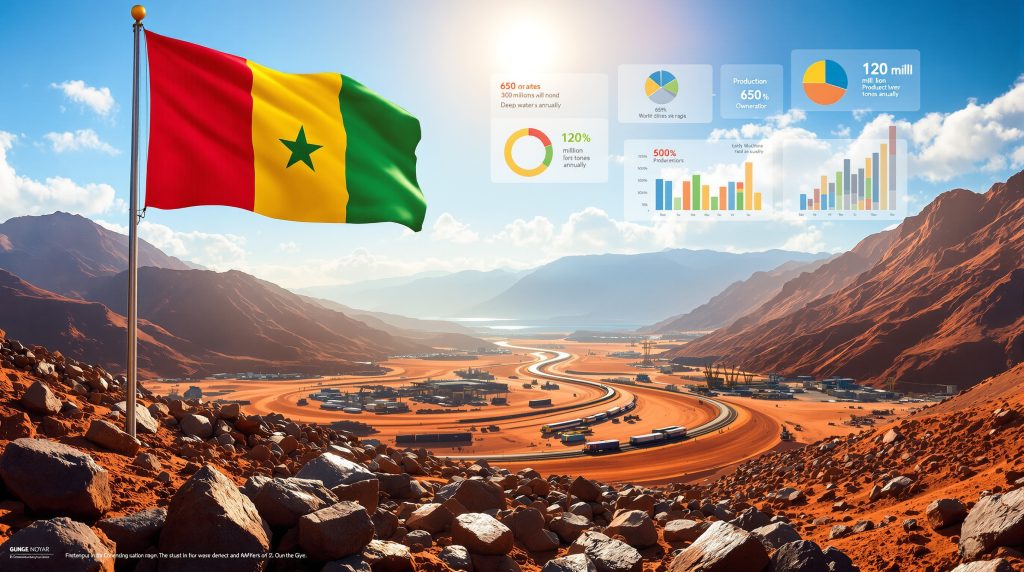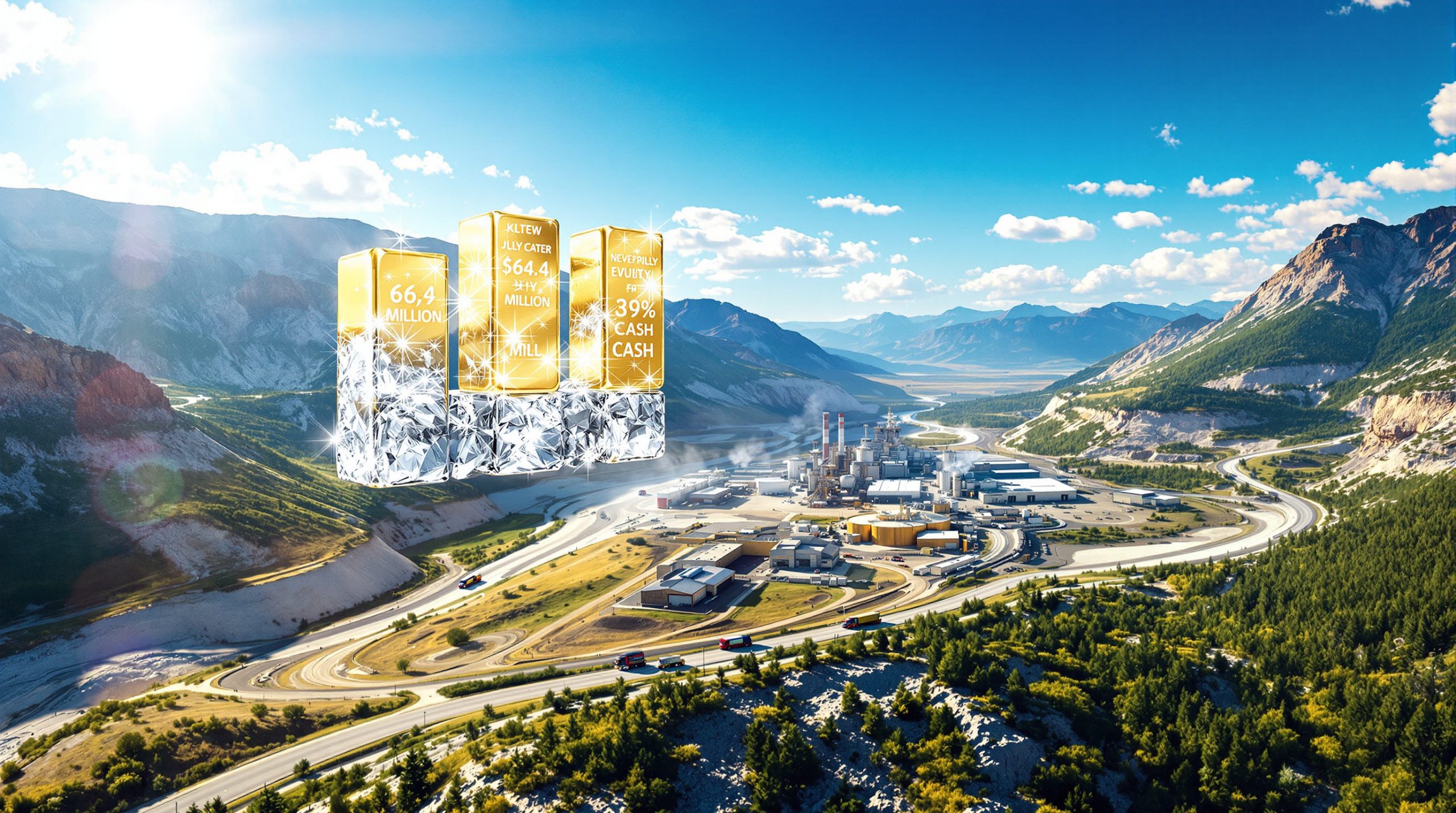What Is the Simandou Iron Ore Project and Why Does It Matter?
The Simandou iron ore project represents one of Africa's most significant mining developments, marking a transformative moment for Guinea's economy and global iron ore markets. Located in Guinea's southeastern mountains, this massive undertaking has finally reached operational status after decades of development challenges.
Table: Simandou Project Quick Facts
| Aspect | Details |
|---|---|
| Location | Southeastern Guinea, West Africa |
| Total Reserves | 2.4 billion tonnes at 65% iron grade |
| Annual Production Target | 120 million tonnes (combined) |
| Infrastructure Investment | $24+ billion |
| Railway Length | 650 kilometers |
| Expected Jobs Created | 45,000 positions |
The project's significance extends far beyond its impressive scale. Furthermore, understanding current iron ore price trends becomes crucial when evaluating Simandou's potential market impact. Rio Tinto CEO Simon Trott described the operation as delivering an exceptional source of high-grade iron ore specifically sought after for low-carbon steel production.
Where Is Simandou Located and What Makes Its Geography Strategic?
Regional Position in West Africa's Mining Belt
The Simandou iron ore project occupies a strategically advantageous position within Guinea's mountainous southeastern region. This location provides access to multiple potential export corridors while connecting to established regional mining infrastructure networks throughout West Africa. The proximity to neighbouring countries like Liberia and Côte d'Ivoire creates opportunities for shared logistics and reduced transportation costs.
The geographical positioning offers significant advantages for international markets. The deposit's location allows for efficient access to both Atlantic shipping routes and regional overland transportation networks, providing operational flexibility that many competing iron ore projects lack.
Geological Formation and Ore Quality
The Simandou mountain range hosts exceptionally rich iron ore formations that distinguish this project from most global competitors. The consistent ore quality throughout the deposit reduces processing complexity and enhances the economic viability of long-term extraction operations.
These geological advantages translate directly into operational benefits. Higher-grade ore requires less beneficiation processing, reducing energy consumption and environmental impact per ton of finished iron ore product. This characteristic becomes increasingly valuable as steel manufacturers face growing pressure to reduce their carbon footprints.
How Is the Simandou Project Structured Across Different Ownership Blocks?
Understanding the Four-Block Development Framework
The Simandou iron ore project operates through a sophisticated dual-consortium structure that divides the massive deposit into complementary operational zones. This arrangement reflects years of complex negotiations between international mining companies, Chinese industrial partners, and Guinea's government.
Table: Ownership Structure by Block
| Blocks | Primary Controller | Key Partners | Production Target |
|---|---|---|---|
| 1 & 2 | Winning Consortium Simandou | Baowu Steel Group | 60 MMt annually |
| 3 & 4 | Simfer JV | Rio Tinto, Chinalco, Guinea Gov't | 60 MMt annually |
Winning Consortium Simandou Operations (Blocks 1 & 2)
Singapore-based Winning International Group leads this consortium in partnership with China's largest steel producer, Baowu Steel Group. Their operational focus centres on the northern sections of the Simandou deposit, with dedicated processing facilities and specialised rail access infrastructure.
WCS Chairman Sun Xiushun emphasised that reaching operational status reflects years of persistent effort and collaborative partnership. This consortium benefits from Baowu's extensive steel industry expertise and secure end-market demand for high-grade iron ore products.
Simfer Joint Venture Structure (Blocks 3 & 4)
Rio Tinto maintains operational leadership through the Simfer joint venture, collaborating with Chinese aluminium giant Chinalco and Guinea's government. This partnership structure balances international mining expertise with Chinese industrial capacity and local stakeholder representation.
The arrangement demonstrates how major mining projects increasingly require multi-national partnerships to manage technical complexity, financing requirements, and political considerations across different jurisdictions.
What Infrastructure Developments Enable Simandou's Operation?
Trans-Guinean Railway Construction
The trans-Guinean railway system represents one of Africa's most ambitious mining transportation projects, spanning more than 600 kilometres of challenging terrain. This multi-use rail network connects the remote Simandou deposits to coastal export facilities whilst serving broader regional economic development objectives.
Engineering challenges throughout the railway construction included:
- Navigating steep mountain gradients and river crossings
- Building weather-resistant infrastructure for tropical conditions
- Coordinating construction across environmentally sensitive areas
- Integrating dual-consortium operational requirements
The railway's multi-use designation means the infrastructure serves Guinea's broader economic development goals beyond Simandou operations. This approach maximises the return on substantial infrastructure investment whilst supporting regional connectivity improvements.
Deep-Water Port and Barge Facilities
Specialised port infrastructure at Forécariah handles the massive iron ore volumes through dedicated loading systems designed for efficiency and environmental compliance. The facility includes both direct loading capabilities for large vessels and transhipment systems accommodating various ship sizes.
The barge and transhipment vessel systems optimise global distribution logistics by allowing flexible cargo handling regardless of vessel specifications. This operational flexibility proves particularly valuable for serving diverse international steel markets with varying port constraints and shipping requirements.
The infrastructure transfer arrangement represents a unique approach where mining operators construct facilities that ultimately become Guinea government assets through the Compagnie du TransGuinéen ownership structure.
When Will Simandou Reach Full Production Capacity?
Production Timeline and Ramp-Up Schedule
The Simandou iron ore project achieved a critical milestone in November 2025 with the commencement of ore transportation from mine sites to port facilities via the completed trans-Guinean railway system. Both WCS and SimFer operations have begun moving iron ore through the integrated infrastructure network.
In addition, analysing iron ore demand insights provides valuable context for understanding Simandou's market timing. The project's production ramp-up coincides with evolving global demand patterns.
Initial Operations Phase (2025-2027)
Testing and commissioning activities are currently underway across all major system components including mining operations, railway transport, and port loading facilities. This comprehensive commissioning process requires simultaneous optimisation of multiple interconnected systems to achieve design capacity levels.
The initial production phase focuses on system reliability and operational optimisation rather than maximum throughput. This approach allows operators to identify and resolve potential bottlenecks before scaling to full production capacity.
Full Capacity Achievement (2028-2030)
Following successful commissioning and ramp-up phases, the combined operations target up to 120 million metric tons of iron ore annually. This ambitious production goal requires seamless coordination between both consortium operations and shared infrastructure systems.
Table: Production Ramp-Up Schedule
| Year | Expected Output (MMt) | Key Milestones |
|---|---|---|
| 2025 | 5-10 | First shipments, system testing |
| 2026 | 25-35 | Railway optimisation |
| 2027 | 50-65 | Port capacity expansion |
| 2028 | 80-95 | Dual-block coordination |
| 2030 | 120 | Full operational capacity |
What Challenges Has the Simandou Project Overcome?
Historical Obstacles and Resolution Strategies
The path to operational status for the Simandou iron ore project required overcoming decades of complex challenges spanning political, technical, and financial obstacles. The project's ultimate success demonstrates the persistence required for mega-scale mining developments in emerging markets.
Political Stability and Regulatory Framework
Guinea's political evolution created significant uncertainty around mining agreements and foreign investment protections throughout the project's development timeline. The country experienced governmental transitions that required renegotiation of key project agreements and regulatory approvals.
The current operational status reflects improved political stability and strengthened legal frameworks supporting large-scale resource development. Guinea's government participation in the operational ceremony demonstrates official commitment to the project's long-term success.
Technical and Logistical Complexities
Extreme weather conditions during West Africa's rainy seasons repeatedly challenged construction schedules and infrastructure development timelines. Engineering teams developed weather-resistant infrastructure designs and seasonal construction planning protocols to address these environmental constraints.
The technical complexity of coordinating dual-consortium operations whilst sharing critical infrastructure required innovative operational agreements and sophisticated logistics management systems.
How Will Simandou Impact Global Iron Ore Markets?
Market Dynamics and Supply Chain Effects
The Simandou iron ore project introduces substantial new high-grade supply into global seaborne iron ore markets. With combined annual capacity reaching 120 million metric tons, the project represents a significant addition to worldwide iron ore availability.
However, understanding how this compares to existing operations requires examining the top iron ore mines 2025 to contextualise Simandou's position in the global landscape.
Seaborne Iron Ore Trade Transformation
Simandou's production capacity will materially impact global iron ore trade patterns and pricing dynamics. The project's high-grade ore specifically targets steel producers focused on low-carbon manufacturing processes, creating a differentiated market segment.
The geographical location provides West African iron ore access to both Atlantic and regional markets, potentially altering traditional trade flows dominated by Australian Pilbara and Brazilian operations.
Competition with Established Producers
Australian Pilbara operations and Brazilian mines face increased competition from Simandou's superior ore grades and strategic positioning. However, established producers maintain competitive advantages through mature logistics networks, operational experience, and lower per-unit transportation costs.
Furthermore, the iron ore price decline scenario demonstrates how increased supply from projects like Simandou could influence market dynamics. Rio Tinto's CEO positioned Simandou as complementing rather than replacing the company's existing world-class iron ore operations.
What Economic Benefits Does Simandou Bring to Guinea?
National Development and Employment Creation
The Simandou iron ore project generates substantial direct and indirect economic benefits for Guinea's national economy. Government Minister Djiba Diakité characterised the project as driving national transformation beyond its mining operations scope.
Direct Employment Opportunities
The project creates approximately 45,000 employment opportunities across multiple operational areas:
- Mining operations and processing facilities
- Railway maintenance and transportation services
- Port operations and logistics management
- Supporting services and local procurement
This employment generation significantly impacts Guinea's labour market whilst providing skills development opportunities in advanced mining technologies and infrastructure management.
Government Revenue and Equity Participation
Guinea's government maintains strategic equity positions in both mining consortiums and infrastructure operations through sophisticated revenue-sharing arrangements. The government holds a 15% ownership stake in the Compagnie du TransGuinéen, which operates the shared rail and port infrastructure.
Revenue streams for the government include royalty payments, corporate taxation, and direct ownership returns from successful operations. The infrastructure transfer arrangement ensures Guinea retains valuable transportation assets beyond the mining project's operational life.
Regional Economic Multiplier Effects
Local procurement requirements and service contracts create secondary economic benefits throughout southeastern Guinea and neighbouring regions. The infrastructure improvements support agricultural and commercial development opportunities extending far beyond mining activities.
The multi-use railway system enables broader regional economic integration and trade facilitation, amplifying the project's positive economic impact across multiple sectors.
How Does Simandou Address Environmental and Social Considerations?
Sustainability Measures and Community Impact
Environmental stewardship and community engagement represent critical components of the Simandou iron ore project's operational framework. The project implements comprehensive protection protocols addressing biodiversity conservation, water management, and community development initiatives.
Environmental Protection Protocols
Comprehensive environmental impact assessments guide restoration activities and biodiversity conservation efforts throughout the project area. Water management systems prevent contamination of local river systems whilst supporting community water access improvements.
The project's focus on high-grade ore production reduces processing requirements and associated environmental impacts per unit of finished iron ore product, aligning with global trends toward more sustainable mining practices.
Community Engagement and Resettlement Programs
Affected communities receive compensation packages, alternative livelihood training programmes, and infrastructure improvements designed to enhance local quality of life. Educational and healthcare facility construction accompanies mining development to provide lasting community benefits.
Table: Environmental Mitigation Measures
| Environmental Aspect | Mitigation Strategy | Monitoring Approach |
|---|---|---|
| Deforestation | Reforestation programmes | Satellite monitoring |
| Water Quality | Treatment facilities | Regular testing |
| Air Quality | Dust suppression | Continuous monitoring |
| Wildlife Protection | Corridor preservation | Species tracking |
What Role Do Chinese Companies Play in Simandou's Development?
Chinese Investment and Strategic Partnerships
Chinese companies occupy central roles in both consortium structures operating within the Simandou iron ore project. This involvement reflects China's strategic focus on securing long-term access to high-quality iron ore resources for domestic steel production requirements.
Baowu Steel Group's Vertical Integration Strategy
China's largest steel producer secures long-term iron ore supplies through direct ownership participation in Winning Consortium Simandou operations. This vertical integration approach reduces input cost volatility whilst ensuring reliable supply chain access for domestic steel manufacturing.
Baowu's involvement demonstrates how Chinese industrial companies increasingly pursue direct resource ownership rather than relying solely on spot market purchases or long-term supply contracts.
Chinalco's Mining Expertise and Technology Transfer
The Chinese aluminium and mining conglomerate contributes advanced extraction technologies and operational expertise to Simfer operations whilst participating in technology transfer programmes supporting local workforce development initiatives.
Chinalco's participation reflects China's broader strategy of combining resource access with industrial capacity building in strategic partner countries throughout Africa and other emerging markets.
How Does Simandou Compare to Other Major Iron Ore Projects?
Global Context and Competitive Positioning
The Simandou iron ore project ranks among the world's largest and highest-quality iron ore developments, distinguished by both resource scale and ore grade characteristics that exceed most global competitors.
Consequently, the project's impact on Australian operations becomes evident, with some analysts discussing Simandou's potential as a "Pilbara killer" due to its superior ore grades and strategic positioning.
Reserve Quality and Longevity
Simandou's estimated 2.4 billion tonnes of reserves at 65% iron grade exceed most global competitors in both quantity and quality metrics. This combination ensures multiple decades of high-grade production capability whilst providing significant operational flexibility.
The superior ore grade reduces downstream processing requirements and transportation costs per unit of usable iron content, creating sustainable competitive advantages in cost-sensitive global markets.
Infrastructure Investment Scale
The estimated $24+ billion infrastructure investment surpasses most contemporary mining projects, reflecting the comprehensive scope of railway, port, and processing facility development required for remote deposit access.
This infrastructure investment scale demonstrates the capital intensity required for world-class mining developments whilst creating lasting economic assets benefiting Guinea's broader national development objectives.
Simandou's high-grade ore requires less processing and generates lower emissions per tonne of steel produced, aligning with global decarbonisation trends in steel manufacturing.
What Are the Long-Term Implications for African Mining Development?
Continental Mining Sector Transformation
The successful development and operation of the Simandou iron ore project establishes important precedents for future large-scale mining developments throughout Africa. The project demonstrates viable models for international partnership structures and infrastructure financing in challenging jurisdictions.
For instance, other Australian mining companies are adapting to new market realities, with resumed iron haulage operations demonstrating how established producers respond to evolving competitive landscapes.
Infrastructure Development Model
Simandou's comprehensive infrastructure approach illustrates how substantial transportation and port investments can unlock previously inaccessible mineral resources across Africa. The railway and port systems create platforms supporting additional mining projects throughout the region.
This infrastructure development model provides a template for future projects requiring significant transportation solutions to access remote but valuable mineral deposits throughout the continent.
Technology Transfer and Skills Development
International partnerships within the Simandou iron ore project create knowledge transfer opportunities benefiting Guinea's broader mining sector development. Local workforce development programmes establish foundations for future resource projects whilst building indigenous technical capabilities.
The skills development initiatives and technology transfer programmes position Guinea to participate more actively in future mining developments as local technical expertise expands and operational experience accumulates. Furthermore, S&P Global's analysis suggests the project could fundamentally reshape global supply dynamics.
Disclaimer: This analysis is based on publicly available information as of November 2025. Mining project developments, production schedules, and market conditions are subject to change based on operational performance, regulatory developments, and global economic conditions. Investment decisions should be based on comprehensive due diligence and current information from official sources.
Looking to Capitalise on Major Mining Discoveries?
Discovery Alert's proprietary Discovery IQ model delivers instant notifications on significant ASX mineral discoveries, empowering investors to identify actionable opportunities ahead of the broader market. Understand why historic discoveries can generate substantial returns by exploring Discovery Alert's dedicated discoveries page, showcasing exceptional outcomes from past discoveries.




